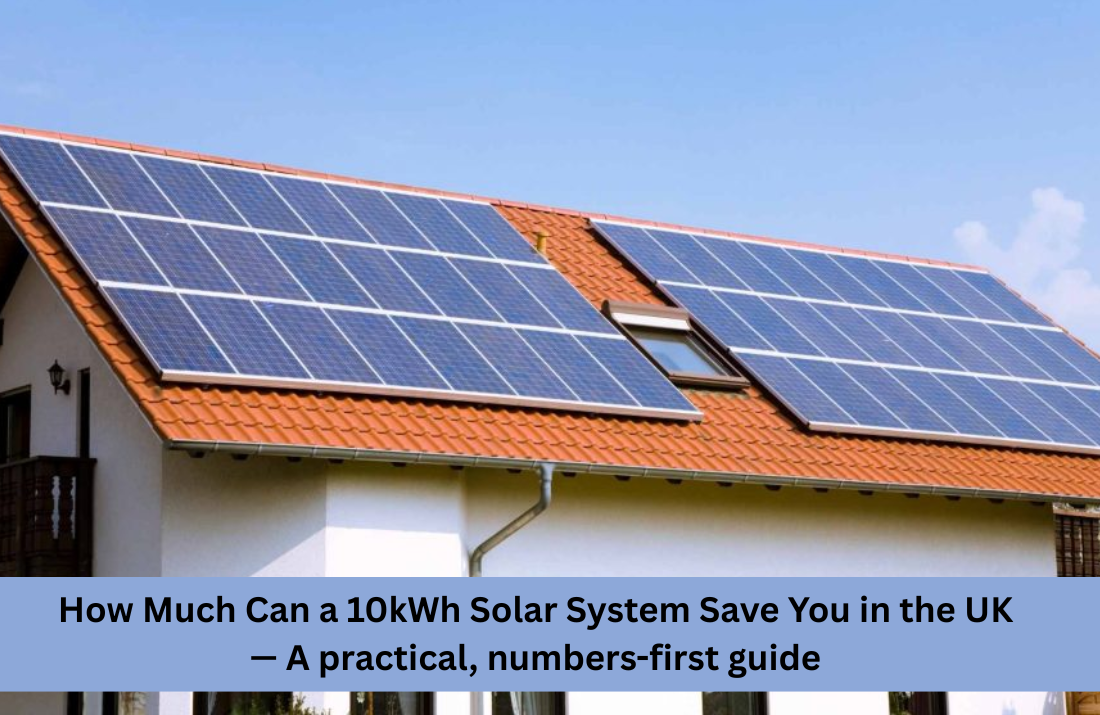If you’re weighing whether a 10 kWh solar system in the UK is good enough for your home or small business, you must know the money you can save. For that, you need an honest assumption backed by the regulator data, not marketing fluff that often leads to misguidance.
With the current electricity price in the country, if one gets a 10KV solar system installed from a verified installer like MAK Energy, they can reduce their energy costs by $1,000 to $2,500. But the savings depend on your energy usage, the SEG tariff rate in your area, and the number of batteries you install.
To help in making better decisions, we have combined industry figures, regulator data, and realistic assumptions so you can see estimated savings, payback expectations, and how to get the maximum savings from a 10 kW system in the UK.
Let’s have a quick summary about a 10kWh solar system.Quick summary
- The installation cost of a 10kWh solar system falls between £12,300 and £15,000.
- An average 10kW solar panel system is likely to produce around 8,000–11,000 kWh a year.
- The average electricity price in the UK is ≈ 25–26 p/kWh under the price cap in 2025. The system can reduce your electricity bill by roughly £1,000–£2,500 per year, depending on the maximum solar energy you consume and whether you add a battery.
- If you install a battery with a 10KV solar PV system, it will increase self-consumption (more of your solar is used at home). But it will increase £3k–£7k to your upfront cost
How much electricity does a 10kW system produce in the UK?
The electricity produced by 10kwh varies by location, roof angle, shading, and solar panel quality. However, on average, a system can produce between 850 and 1,100 kWh per kW of installed capacity. So, if you have a 10kW system installed on your roof, it means the system will produce 8,500–11,000 kWh per year.What are the two major factors that determine your savings?
Estimating the exact amount one can save with a solar system is difficult, as it varies depending on several factors. Here are two significant factors that will determine the savings.1. How much of the Solar panels’ generation you actually use yourself (self-consumption)
If you are using or storing energy produced by the solar panels, you directly save 25–26 p/kWh. The more you utilize, the more you save.2. How much you export to the grid and what you are paid for it (SEG)
The export rate varies depending on your energy provider company. Some reasonable tariffs pay ~15p, but the average tariff rate ranges from 5 to 12p. Therefore, if you are receiving a higher tariff rate for every kWh you sell, it will automatically increase the savings amount. People who use electricity at home save more than those who export the electricity. Because import prices are typically higher than SEG export payments.How Much Can You Save with a 10kWh Solar System?
The 10kWh solar system is typically installed for small businesses or large homes in the UK, and the upfront cost depends on the battery installation, as do the savings. Therefore, we will calculate the savings of this system with two scenarios: with and without battery installation.A. Saving on a 10kWh solar system in the UK without a battery
The Mak Energy intensive studies on solar energy in the UK have found that UK households typically self-consume around 40–50% of their solar generation without a battery. For our calculations, we will use 45% as a realistic industry average. 9000KWH Solar panels production every year and SEG rate at 10p/kwh/ and the electricity rate at £0.257.- Self-consumed energy = 9,000 × 45% = 4,050 kWh.
- Savings from electricity you import from the grid = 4,050 × £0.257 = £1,042/yr.
- Exported energy = 9,000 − 4,050 = 4,950 kWh.
- SEG income = 4,950 × £0.10 = £495/yr (at 10p/kWh average).
Savings with a 10kW Solar System and Battery in the UK
When you pair a properly sized solar battery with a 10kW solar system in the UK, you can boost your self-consumption of solar energy to as high as 80%. However, to make the calculation more realistic, we will use 70% for a house that usually charges the battery during the day and drains it at night. Here is the estimated savings on a 10kWh solar system with a battery storage system.- Self-consumed energy = 9,000 × 70% = 6,300 kWh.
- Savings from avoided import = 6,300 × £0.257 = £1,619/yr.
- Exported energy = 9,000 − 6,300 = 2,700 kWh.
- SEG income = 2,700 × £0.10 = £270/yr.
How Long Until a 10kW Solar System Pays for Itself?
If we look at the typical 10kW solar system cost in the UK, including solar panels, solar inverter, mounting structure, and installation charges, it’s currently around £12k–£15k, depending on the equipment and roof complexity. And by adding a battery to the system, the overall cost can increase by £3k–£7k. Based on this installation cost, we can now estimate the payback period- 10KW Solar System cost = £14,000 (without battery).
- Annual Saving = £1,537 (as we calculated above).
- Simple payback = 9–10 years
Things that can make a noticeable difference in Your Savings
Roof orientation & shading
Ensure your solar panels are installed in a South-facing and unshaded direction. In this direction, they will yield the most energy. If your roof is north-facing or heavily shaded, the electricity generation could be less than average.Household timing of use
To increase the self-consumption rate, run the maximum appliance during daytime, like washing machines, EV charging, and heat pumps. The increasing daytime results in a higher savings rate.Adding a battery
If you don’t have a budget issue, don’t go without a battery. The storage system increases self-use, and also gives you a backup option for outages, and can boost returns when paired with reasonable SEG tariffs.Choosing the right SEG/supplier package:
There are dozens of suppliers in the UK; choose the one with the best tariff rates.How we help?
If you are really planning to invest in solar energy, and would like precise numbers for your property, MAK Energy offers a free site assessment & tailored quote that includes:- An on-roof generation estimate using your postcode and orientation
- A full cost breakdown (panels, inverter, scaffolding, export meter, battery options),
- Estimated annual savings and payback using your real electricity bills




